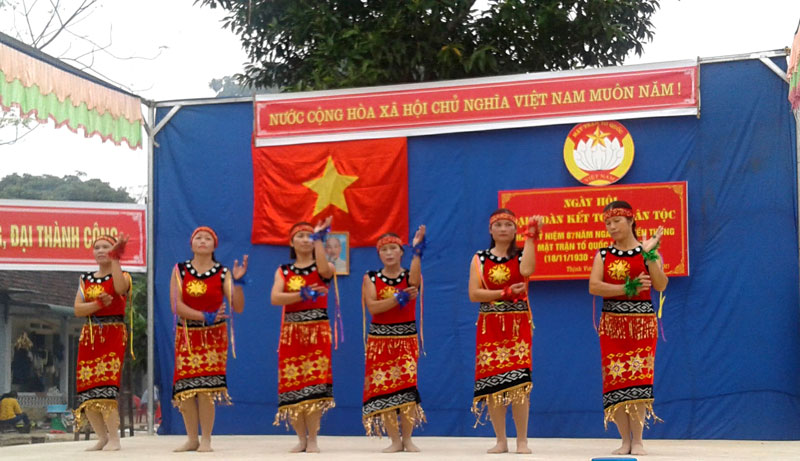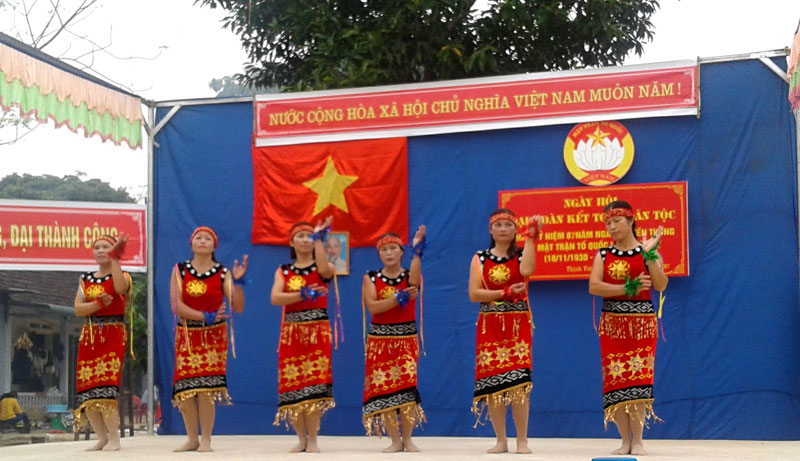
(HBO) - Determining that the economic development, hunger eradication and poverty reduction are the most important tasks in building a new cultural life, the Steering Committee of the commune has cooperated with the Fatherland Front and other mass organizations to actively propagate and mobilize the people to transfer the appropriate crop structure, implementing the land consolidation and plot exchange, using new varieties and applying techniques in production and so on.
Accordingly, the average income per capita of the commune has reached 31.5 million VND. The rate of the poor households has decreased to 6.39%. The people have agreed to join hands in building a new countryside. Currently, Lac Thinh has reached 13 out of the 19 criteria of building a new countryside. Among the unfulfilled criteria, it is difficult to achieve the criteria of cultural and physical foundations. To solve the above problem, the Party Committee and the People’s Committee of the commune have actively mobilized people to donate land to build the cultural houses and they have received enthusiastic responses from the people.

The people in Lac Thinh commune (Yen Thuy) have been actively participating in cultural and arts movement to enrich their spiritual life.
The purpose of building a new cultural life is to push back the backward customs and practices and to promote the fine traditions and customs and the identity of the national cultural traditions. More than 80% of Lac Thinh's population is Muong. In the past, the wedding party used to last for many days, now it has been improved significantly. Most of the weddings have been organized according to a civilized lifestyle, not for a long time, there is no situation of being drunk leading to fighting and causing disorder. The funeral has also changed positively. All the funerals have been organized simply, thoughtfully and respectfully by the party committee, the committee of the front and the unions and other organizations.
In addition, the Party Committee and the People’s Committee of Lac Thinh commune are paying special attention to preserving the national cultural identity through the cultural and artistic activities and the traditional local festivals. Currently, each hamlet has set up their own arts team. On the occasion of holidays, New Year, the arts teams exchange with each other. The performances of gongs and songs of Muong people are nicely shown by the nucleus of arts. Additionally, De Rice Tet is a unique cultural feature of Muong ethnic people in Lac Thinh. Every year, on October 26 of the lunar calendar, the people of Muong Ram organize their traditional De Rice Tet
Thanks to the effective implementation of the movement to build the cultural life, in 2018 there were 8 out of the 15 villages reaching the cultural villages in Lac Thinh. 78% of the households reached the title of the cultural families. In 2019, implementing the merger, there are only 11 helmets in the commune. They are trying to have 8 out of the 11 villages reaching the cultural villages with the average income per capita of 33.5 million VND.
Hoa Binh province has carried out multiple programmes and initiatives to revive its cultural heritage which has gradually fallen into oblivion through the ebbs and flows of history.
The most prominent and defining feature in the prehistoric era of Hoa Binh is the Hoa Binh Culture. The Culture was first discovered in Hoa Binh. The significant prehistoric culture represents not only Vietnam but also Southeast Asia and southern China. Through excavations of cave sites in the limestone regions of Hoa Binh, French archaeologist M. Colani introduced the world to a "Stone Age in Hoa Binh province – Northern Vietnam" in 1927. On January 30, 1932, the First Congress of Far Eastern Prehistorians, held in Hanoi, officially recognised the Hoa Binh Culture.
Known as the "Land of Epic History”, Hoa Binh province, the gateway to Vietnam’s northwest, boasts a strategic location and a unique cultural tapestry woven by its ethnic minority communities.
The People's Committee of Luong Son District recently held a ceremony to receive the certificate recognizing Sau Communal House in Thanh Cao Commune as a provincial-level historical and cultural site.
Recognising the importance of cultural heritage preservation in protecting and promoting the value system of Vietnamese culture, and serving socio-economic development in the new period, Party committees and local administrations in Hoa Binh province have identified it as a key task in the cultural development strategy. The province has been making efforts in mobilising resources, creating consensus among people and engaging ethnic communities in preserving and promoting cultural identity.
Hoa Binh province has captured growing attention both domestically and internationally for its distinctive cultural heritage and rich history. Most notably, it has been renowned for its famous Hoa Binh culture, considered the cradle of ancient Vietnamese civilisation. Looking ahead to significant milestones in 2025 and the 140th anniversary of province establishment in 2026, Hoa Binh Newspaper presents a comprehensive overview of the province's development across economic, social, cultural, tourism, and security domains.



